History of Chemical Engineering at Penn State
Early Origins
The roots of chemical engineering at Penn State can be traced to the formation of the chemistry program in 1888. The program, led by Dr. George Gilbert Pond, produced many prominent graduates. Among them was William H. Walker, the first B.S. graduate of chemistry at Penn State, and a future pioneer of chemical engineering. Walker went on to advance his studies and later moved to MIT where he played an important role in laying the foundation for the chemical engineering program there. Walker retained close ties to Penn State by serving on the Board of Trustees and acted as an adviser to the college. In 1924, Walker collaborated with W.K. Lewis and W.H. McAdams to co-author the first chemical engineering textbook, Principals in Chemical Engineering.
Penn State Chemical Engineering Beginnings
In 1924 the first curriculum in chemical engineering at Penn State was introduced, with the course foundation being based upon the text by Walker, Lewis, and McAdams. The first graduating class of 11 students received their degrees on June 15, 1925, and for the next 40 years the program remained steady, graduating approximately 50 students each year.
Creation of the Penn State Department of Chemical Engineering
In 1948 the department of chemical engineering was officially recognized and was separated from the department of chemistry. In 1959, the program underwent its first major restructuring as the Petroleum Refining Laboratory was officially merged with the department of chemical engineering. Merrrell Fenske, who had helped establish and manage the Petroleum Refining Laboratory, was appointed as the new department head. At this time, the department moved into the newly constructed Chemical Engineering Unit 1 Building on Shortlidge Road, which cost approximately $800,000 to complete.
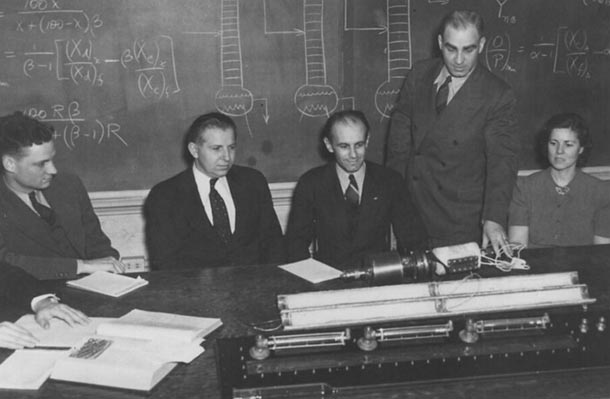
Merrell Fenske (standing, with Dorothy Quiggle to his left) discussing procedures and apparatus used in the Petroleum Refining Laboratory.
In 1968, the second phase of the construction, the Chemical Engineering Unit 2 (east wing) was completed. The building included the Center for Air Environmental Studies as well as classrooms, graduate research laboratories, and staff and faculty offices. The two units were subsequently connected in 1973 and renamed as Fenske Laboratory in honor of Merrell Fenske’s contributions to the field of chemical engineering and Penn State.
Chemical Engineering – Moving Forward
The department of chemical engineering became part of the College of Engineering in 1963 and began to enjoy formidable growth. Lee C. Eagleton served as department head from 1970-1983. The undergraduate program grew steadily through the 1970s, and then experienced nearly explosive growth in the late 1970s and early 1980s. Undergraduate enrollment soared approximately 150%. This growth was driven largely by the U.S. response to the oil crises in 1973 and 1979 and the subsequent investment in the synthetic fuels (synfuels) program by the President Carter administration.
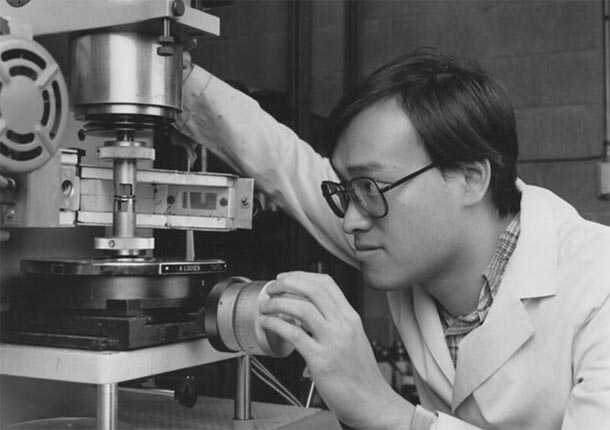
Chemical engineering graduate student Han-Chern Ling uses a rheometrics mechanical spectrometer to measure viscoelastic properties of polymers in 1984.
In 1983 J. Larry Duda was named chemical engineering department head. Duda is credited with ushering in a modern era of chemical engineering at Penn State as well as strengthening the department’s connections with industrial partners. Duda hired many of the departments leading faculty including: Kristen Fichthorn, Wayne Curtis, Themis Matsoukas, Ali Borhan, Costas Maranas, Darrell Velegol, and Janna Maranas. The department also established the Center for the Study of Polymer-Solvent Systems in 1990, co-directed by Larry Duda and Ron Danner. Duda was elected to the National Academy of Engineering in 1998 for his “research on molecular transport in polymers and on tribology, and for leadership in engineering education.” His contributions to the department, the profession, and Penn State were honored with the establishment of the Dow Chemical Company and Larry Duda Excellence in Chemical Engineering Fund in 2006 through a $2 milion gift from Dow.
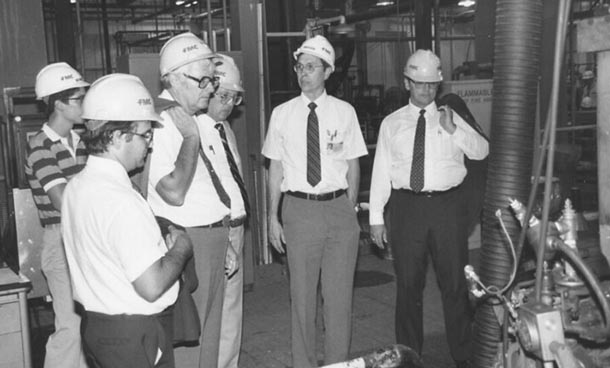
From left to right; Robert Lombardo, junior chemical engineering summer intern; Dr. Uri Tsach, mechanical engineering; Dr. Larry Duda, chemical engineering; Dr. Harold Jacobs, mechanical engineering; Blenton Clement, manager of process support; Dean Meier, at a chemical pilot facility in Princeton, NJ.
Henry C. (Hank) Foley became department head in 2000, having been recruited to Penn State from the University of Delaware. Foley moved the department strongly into the area of nanoscience and nanotechnology, both through his own research on nanoporous carbons and through the hiring of Seong Kim and Antonios Armaou. Foley also continued the department’s tradition of having someone with significant industrial experience teach the senior design course, with Robert Nedwick (and now Dawn McFadden) taking over that role after Jack McWhirter’s retirement from the faculty. Foley was appointed as Associate Vice President for Research and Director of Strategic Planning at Penn State in 2004, and subsequently served as Dean of the College of Information Sciences and Technology before becoming Vice President of Research and Dean of the Graduate School in 2009.
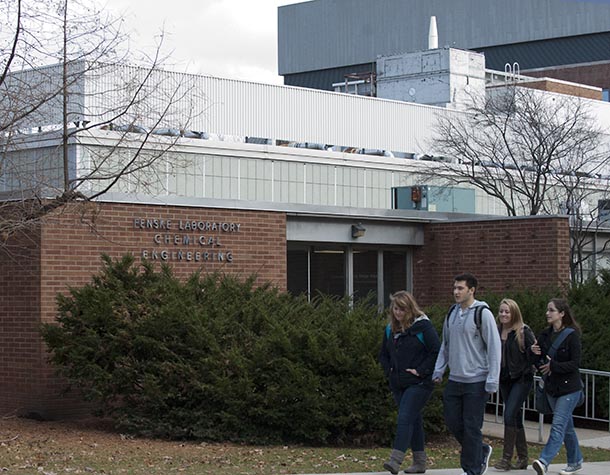
Fenske Laboratory in 2011.
Andrew L. Zydney was appointed Interim Department Head upon Foley’s move to Old Main, taking over the position on a permanent basis in 2005. Zydney helped lead a major revitalization of the department, hiring a diverse range of junior and senior faculty: Michael Janik (2006), Scott Milner (2008), Robert Rioux (2008) Enrique Gomez (2009), Howard Salis (2009), Kyle Bishop (2010), Angela Lueking (2011), Esther Gomez (2011), Manish Kumar (2011), and Thomas Wood (2011). In 2014 Zydney stepped down from the department head position to focus on teaching and research. In 2015 he was named a Distinguished Professor of Chemical Engineering in addition to his numerous awards and accolades.
In August 2014, Phillip E. Savage, who had served as the Arthur F. Thurnau Professor and interim department head of chemical engineering at the University of Michigan, became the newest department head. Under Savage’s direction, the department is poised for prolific growth. In 2019, the chemical engineering department, along with the Department of Biomedical Engineering, opened the state-of-the-art Chemical and Biomedical Engineering Building. The facility is located on the former site of Fenske Laboratory and is anticipated to support the growth, innovation, and goals of the department for the next several decades.
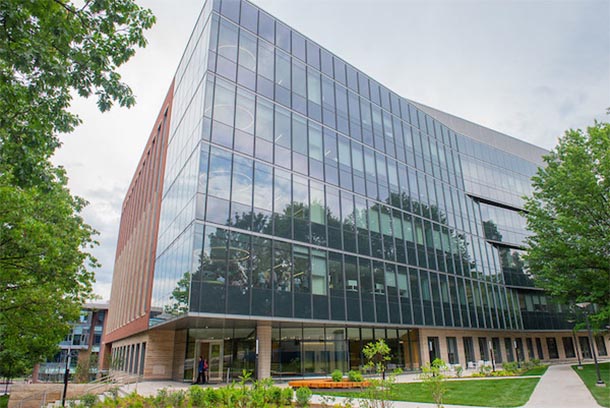
The Chemical and Biomedical Engineering Building, dedicated in 2019.



